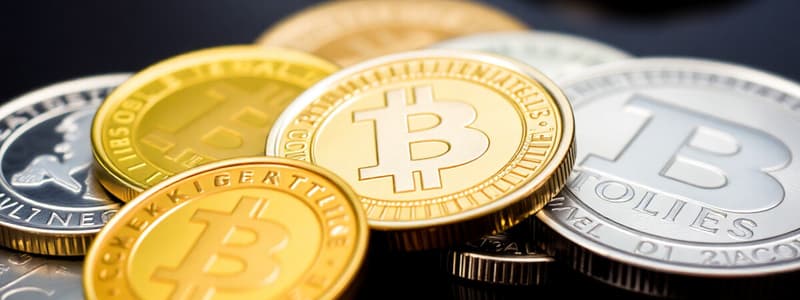Podcast
Questions and Answers
What is reeding in relation to coins?
What is reeding in relation to coins?
- The grooves on the edges of certain coins (correct)
- The precious metal content of the coin
- The weight of the coin
- The design printed on the coin's face
What materials are clad coins made from?
What materials are clad coins made from?
- Aluminum and bronze
- Gold and silver
- Silver and brass
- Copper and nickel-zinc (correct)
Why are the coins discussed not considered true coins?
Why are the coins discussed not considered true coins?
- They are made entirely of recycled material
- They are only issued by private organizations
- They are made from aluminum
- They contain no precious metals (correct)
What does the dollar bill say above Washington's picture?
What does the dollar bill say above Washington's picture?
What change occurred to dimes, quarters, and halves after 1965?
What change occurred to dimes, quarters, and halves after 1965?
Before 1965, the dimes, quarters, and halves were made entirely of what material?
Before 1965, the dimes, quarters, and halves were made entirely of what material?
What is the purpose of explaining money before discussing inflation and recession?
What is the purpose of explaining money before discussing inflation and recession?
What does the author suggest about people discussing inflation and recession?
What does the author suggest about people discussing inflation and recession?
What does the phrase 'forewarned is forearmed' imply in the context of understanding inflation and recession?
What does the phrase 'forewarned is forearmed' imply in the context of understanding inflation and recession?
Which aspect of coins does the author emphasize as linked to economic issues?
Which aspect of coins does the author emphasize as linked to economic issues?
Flashcards
Reeding
Reeding
Grooves found on the edges of some US coins. They help prevent counterfeiting and wear and tear.
Clad Coins
Clad Coins
Coins made of copper sandwiched between nickel-zinc metal.
Coin
Coin
A disk of precious metal like gold or silver, used as a medium of exchange.
Token
Token
Signup and view all the flashcards
Silver
Silver
Signup and view all the flashcards
Base Metals
Base Metals
Signup and view all the flashcards
Before 1965
Before 1965
Signup and view all the flashcards
Inflation
Inflation
Signup and view all the flashcards
Recession
Recession
Signup and view all the flashcards
Federal Reserve Note
Federal Reserve Note
Signup and view all the flashcards
Study Notes
Understanding Money
- Money, including coins and paper currency, is fundamental to understanding inflation and recession.
- These economic concepts affect careers, businesses, and investments.
- Even experts, like teachers, journalists, and politicians, can find them confusing.
- The letter aims to clarify these concepts and equip readers to understand future economic challenges.
Coin Characteristics
- Examine a set of coins (penny, nickel, dime, quarter, half-dollar, dollar bill).
- Notice the reeding on some coins (not on pennies and nickels). This plays a role in the topic.
- Observe the clad structure (nickel-zinc and copper sandwich) differentiating modern coins from older ones.
- Older coins were composed of nearly pure silver, while modern coins often contain a combination of metals to reduce their cost.
- Coins dated before 1965 (mostly made of silver) are less frequent (limited circulation) because of inflation/recession.
- Coins are actually "tokens"; those made of precious metals are true coins.
Paper Currency
- Examine a dollar bill. It's a Federal Reserve Note, not a "Silver Certificate" (as was the case historically).
- The note's legal tender status is important.
- These features of coins and paper currency are all linked to inflation and recession.
Studying That Suits You
Use AI to generate personalized quizzes and flashcards to suit your learning preferences.



